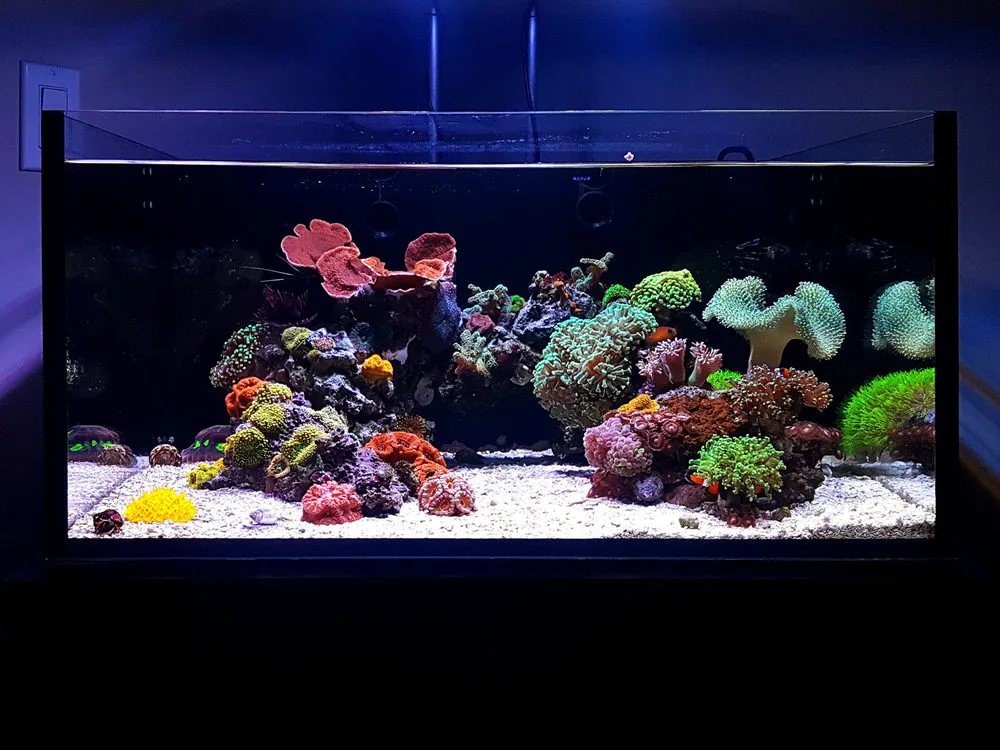Stunning 25-Gallon Reef Tank – Clown79's TOTM | NanoReef

Tank Specifications
Volume: 25 Gallons / 94 Liters
Dimensions (L × W × H):
24.0" ×
20.0" ×
12.0"
61.0cm ×
50.8cm ×
30.5cm
Equipment List
- Salt: ESV
Frequently Asked Questions
How often should I conduct water changes in a reef tank?
For a 25-gallon reef tank, it's recommended to perform 3-4 gallon water changes every 1-2 weeks. This helps maintain water quality. Scrape algae from the glass, use a turkey baster on the rocks, vacuum the sand bed lightly, and change filter floss during water changes.
What should I do to maintain the health of my corals?
Healthy corals require proper feeding, lighting, and water quality. Feed your corals once a week, focusing on spot feeding LPS (Large Polyp Stony) corals and broadcast feeding SPS (Small Polyp Stony) corals. Turn off water movement for about 10-30 minutes during feeding to ensure they can eat. Regularly test parameters like alkalinity, calcium, and magnesium.
What is the best way to control algae in my reef tank?
To control algae, maintain nutrient levels, avoid overfeeding, and ensure proper water flow. If algae becomes an issue, use a turkey baster to physically remove excess algae and manually scrape it from surfaces. Consider increasing biodiversity with invertebrates like snails that help control algae.
How should I feed my fish in a reef tank?
A varied diet is crucial for keeping fish healthy. Feed daily using a combination of PE Mysis flakes, New Life Spectrum Thera A pellets, Omega pellets, and frozen foods like Hikari Frozen mysis. This ensures a well-rounded nutritional intake.
How can I effectively feed my corals?
For effective coral feeding, use a mix of spot feeding for LPS corals and broadcast feeding for SPS corals. It’s best to feed when water flow is turned off for 10 minutes to allow corals to take in food without it getting lost in the filter.
What lighting should I use for a nano reef tank?
LED lights such as Ai Prime HD are excellent choices for nano reef tanks. It's essential to research the specific lighting needs of your corals to ensure they receive adequate light intensity (PAR) and spectrum for optimal growth and color.
What filtration is suitable for a reef tank?
Utilize filter media such as filter floss, activated carbon, and Purigen in media baskets. Change filter floss weekly and consider changing carbon every 2-3 weeks to maintain water clarity and quality.
How do I manage dinoflagellates in my reef tank?
To combat dinoflagellates, first confirm their presence. Stop water changes and reduce your light period. Increase nutrient levels to create less favorable conditions for dinoflagellates by dosing phytoplankton, and increase coral feedings. Regularly suck out visible dinoflagellates and use activated carbon to maintain water quality.
What should I do if my corals are not thriving?
Check water parameters (alkalinity, calcium, magnesium) regularly and ensure your nutrients are balanced. Make sure your lighting is appropriate and provides the right intensity and wavelength for your specific coral species. Observe the water flow and adjust if certain corals appear unhappy.